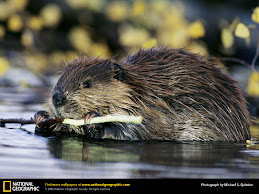 Not long ago, children spent the lion’s share of their free time outdoors, all pickup baseball games and flashlight tag, bike riding and fort building. City kids played street games and hung out.
Not long ago, children spent the lion’s share of their free time outdoors, all pickup baseball games and flashlight tag, bike riding and fort building. City kids played street games and hung out.The indoor world belonged to our parents. We owned the streets and vacant lots.
But today, numerous trends have colluded to disconnect kids from the outdoors, and Richard Louv’s book, “Last Child in the Woods” coined the phrase—and garnered a heap of attention—nature-deficit disorder as the new name for this estrangement.
Kids are time-stressed and time-managed, chauffeured from ballet to soccer to play dates. Technology is complicit: kids play inside “’cause that’s where all the electrical outlets are,” one fourth grader says in the book. Parents have colluded in this, fear of strangers, ticks and West Nile preventing parents from allowing kids to play outdoors or walk to school. Overdevelopment and liability issues have kept kids away from green spaces, visitation to national parks has dropped, and, adding insult to injury, schools have downsized recess, giving kids no outdoor time during the week.
And a child in the 1990s roams over a territory only one-ninth of what it was in 1970. Obesity is rampant, as are attention deficit disorders, hyperactivity, and even depression. The average kid watches almost 40 hours a week of screens-- TV, computer, I-phone-- it's their full-time job.
Louv weaves together what Scientific American calls “acres of evidence” showing the need to connect kids to nature. To summarize, children with access to nature and the outdoors learn better, behave more calmly and appropriately, are more creative, and better at critical thinking. Time in nature fills their physical, emotional and spiritual deficits.
And nature needs children, too, but the next generation of John Muirs and Rachel Carsons are locked indoors. Since evidence indicates green giants get their green genes from outdoor inspiration, children will not seek nature as their life’s work.
The solution? What Louv calls “nature-child reunion” that returns kids to the outdoors.
Lots of groups are working on this issue, like the Children and Nature Network, created by Louv himself. I direct a small nonprofit, the Lower Merion Conservancy, that has begun addressing the disorder with a preschool group.
But mostly, it’s the job of parents to open our front doors and kick our kids outside.
Get out! It’s one solution to a world of problems.
But today, numerous trends have colluded to disconnect kids from the outdoors, and Richard Louv’s book, “Last Child in the Woods” coined the phrase—and garnered a heap of attention—nature-deficit disorder as the new name for this estrangement.
Kids are time-stressed and time-managed, chauffeured from ballet to soccer to play dates. Technology is complicit: kids play inside “’cause that’s where all the electrical outlets are,” one fourth grader says in the book. Parents have colluded in this, fear of strangers, ticks and West Nile preventing parents from allowing kids to play outdoors or walk to school. Overdevelopment and liability issues have kept kids away from green spaces, visitation to national parks has dropped, and, adding insult to injury, schools have downsized recess, giving kids no outdoor time during the week.
And a child in the 1990s roams over a territory only one-ninth of what it was in 1970. Obesity is rampant, as are attention deficit disorders, hyperactivity, and even depression. The average kid watches almost 40 hours a week of screens-- TV, computer, I-phone-- it's their full-time job.
Louv weaves together what Scientific American calls “acres of evidence” showing the need to connect kids to nature. To summarize, children with access to nature and the outdoors learn better, behave more calmly and appropriately, are more creative, and better at critical thinking. Time in nature fills their physical, emotional and spiritual deficits.
And nature needs children, too, but the next generation of John Muirs and Rachel Carsons are locked indoors. Since evidence indicates green giants get their green genes from outdoor inspiration, children will not seek nature as their life’s work.
The solution? What Louv calls “nature-child reunion” that returns kids to the outdoors.
Lots of groups are working on this issue, like the Children and Nature Network, created by Louv himself. I direct a small nonprofit, the Lower Merion Conservancy, that has begun addressing the disorder with a preschool group.
But mostly, it’s the job of parents to open our front doors and kick our kids outside.
Get out! It’s one solution to a world of problems.


No comments:
Post a Comment